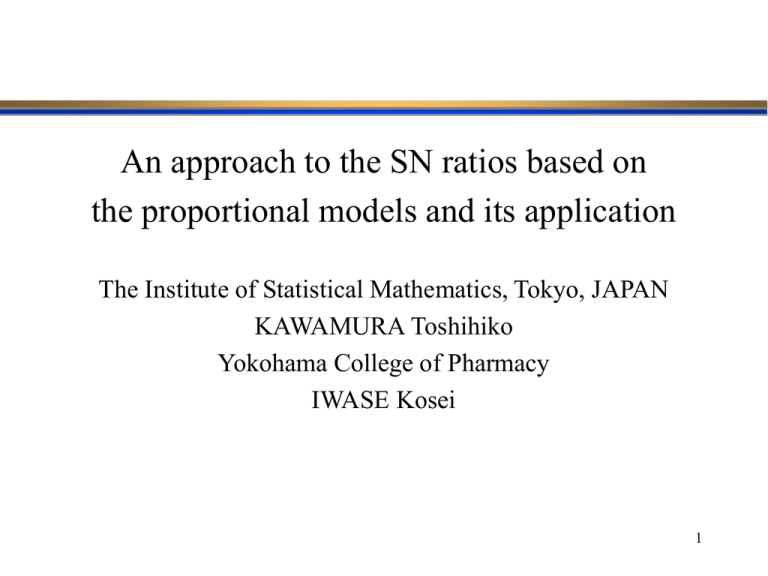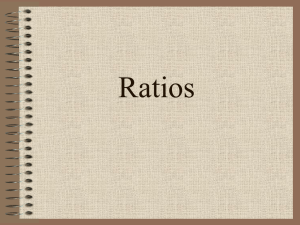Chapter 7 Supp. – Taguchi Design of Experiments
advertisement

An approach to the SN ratios based on the proportional models and its application The Institute of Statistical Mathematics, Tokyo, JAPAN KAWAMURA Toshihiko Yokohama College of Pharmacy IWASE Kosei 1 Robust Parameter Design Outline • • • • Taguchi Design of Experiments Robust Parameter Design Signal-to-Noise (SN) ratios The testing problem of the equality for two SN ratios 2 Taguchi Design of Experiments • Robust Parameter Design, also called the Taguchi Method pioneered by Dr. Genichi TAGUCHI, greatly improves engineering productivity. – Comparable in importance to Statistical Process Control, the Deming approach and the Japanese concept of TQC • Robust Parameter Design is a method for designing products and manufacturing process that are robust to uncontrollable variations. – Based on a Design of Experiments (Fisher’s DOE) methodology for determining parameter levels • DOE is an important tool for designing processes and products – A method for quantitatively identifying the right inputs and parameter levels for making a high quality product or service • Taguchi approaches design from a robust design perspective 3 The Taguchi Approach to DOE • Traditional Design of Experiments (Fisher’s DOE) focused on how different design factors affect the average result level • Taguchi’s DOE (robust design) – Variation is more interesting to study than the average – Run experiments where controllable design factors and disturbing signal factors take on 2 or 3 levels. 4 Robust Design (I) • By consciously considering the noise factors and the cost of failure in the Taguchi method helps ensure customer satisfaction. – Environmental variation during the product’s usage – Manufacturing variation, component deterioration • Noise factors (Disturbances) are events that cause the design performance to deviate from its target values • A three step method for achieving robust design 1. Concept design 2. Parameter design 3. Tolerance design • The focus of Taguchi is on Parameter design 5 Robust Design (II) Robust Parameter Design (e.g. Wu and Hamada 2000) – A statistical / engineering methodology that aim at reducing the performance “variation” of a system. The selection of control factors and their optimal levels. – The input variables are divided into two board categories. Control factor: the design parameters in product or process design. Noise factor: factors whoes values are hard-to-control during normal process or use conditions – The “optimal” parameter levels can be determined through experimentation 6 Signal to Noise (SN) Ratios (I) Performance measure Taguchi’s SN ratio 7 Signal to Noise (SN) Ratios (II) 8 The Taguchi Quality Loss Function • The traditional model for quality losses – No losses within the specification limits! Cost Scrap Cost LSL Target USL • The Taguchi loss function – the quality loss is zero only if we are on target loss function risk function SN ratios 9 A new performance measure (I) However, if the adopted principles of the signal-response systems are diffent and the physical quantities of the response values are different between the systems, the comparison of the Taguchi’s SN ratios has no sense. A new performance measure for the systems : We propose a dimensionless SN ratios (Kawamura et al. 2006). – Proportional model, K loss function, Dynamic SN ratios – The response and the signal factor values are positive real values. 10 A new performance measure (II) The response and the signal factor values are positive real values. Consider two-parameter statistical models for positive continuous observation. • Log normal distribution • Gamma distribution • Inverse Gaussian distribution etc. Error distribution 11 A new performance measure (III) K loss function K risk function 12 A new performance measure (III) Calculation ! 13 A test of the Equality for two SN ratios (I) • We consider the testing problem of the equality for two SN ratios – SN ratios for the systems with Dynamic Characteristics – Performance comparison of the systems y y A1 M1 M 2 M 3 A2 M4 M M1 M 2 M 3 M4 M 14 A test of the Equality for two SN ratios (II) y y A1 SN ratio A2 SN ratio A1 K M1 M 2 M 3 M4 Data 2 A2 Data 1 K 2 1 M M1 M 2 M 3 M4 M Which performance is good ? Testing homogeneity of SN ratios 15 A test of the Equality for two SN ratios (III) Null hypothesis A Variance Stabilizing Transformation Approximation Test 16 A numerical example (I) 17 A numerical example (II) Significant level 1% Not significant ! In this example, the significant difference of the SN ratios between A1and A2 is not shown. 18











